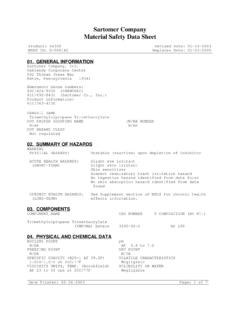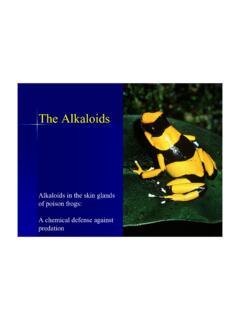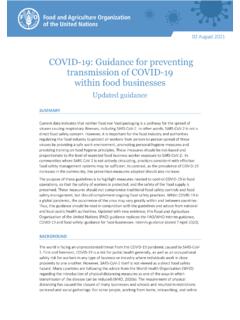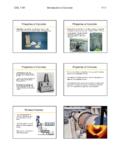Transcription of Types, Properties & Uses of Hypalon
1 Technical Information 1 Hypalon is the registered trademark for a series ofchlorosulfonated polyethylene synthetic rubbersmanufactured by DuPont Dow Elastomers. Vulcani-zates of Hypalon are highly resistant to the deterio-rating effects of ozone, oxygen, weather, heat, oil andchemicals. Hypalon resists discoloration on exposureto light, and is widely used in light-colored vulcani-zates. It can be compounded to give excellentmechanical Properties for example, high tensilestrength and abrasion types and grades of Hypalon are availablefor a variety of end use requirements. A generaldescription of each of these products is shown inTable 1, and additional details are given in othersections of this technical bulletin. All of these typesmay be processed and used in the usual manner forsolid elastomeric vulcanizates.
2 However, severaltypes are also of value in two additional areas unvulcanized applications and solution compounding with Hypalon , proper selectionof polymer type is the starting point for a suitablefinished product. Equally important is the selectionof the other compounding ingredients . A generaloutline of compounding ingredients and their functions (arranged in alphabetical order) is technical bulletin is intended as a brief guide toselection of the most suitable type of Hypalon thefirst step in developing a practical, serviceable com-pound to meet the requirements of a Precautions for Hypalon Safe HandlingHypalon synthetic rubber contains low levels ofcarbon tetrachloride (CCl4) and chloroform (CHCl3)as residues from manufacturing. Carbon tetrachlorideand chloroform are classified by The InternationalAgency for Research on Cancer (IARC), the NationalTypes, Properties and Uses of Hypalon Toxicology Program (NTP), and the AmericanConference of Governmental Industrial Hygienists(ACGIH) as substances for which there is limitedevidence of carcinogenicity to humans.
3 Under theOccupational Safety and Health Act (OSHA), expo-sures to carbon tetrachloride must be kept below thepermissible exposure limit of 10 ppm and chloroformmust be kept below the permissible exposure limit of50 ppm. When large quantities of raw polymer arestored or processed in enclosed areas with restrictedair exchange or ventilation, the air must be monitoredfor carbon tetrachloride and chloroform; and, ifnecessary, ventilation must be supplied to comply withOSHA additional information concerning this and otherpotential industrial health hazards when handlingHypalon , see DuPont Dow Elastomers technicalbulletin, Toxicity and Handling Guide, and theMaterial Safety Data Sheet (MSDS).Compounding IngredientsCompounding ingredients , including peroxides andlead-based curatives, used with Hypalon to preparefinished products, may present hazards in handlingand use.
4 Before proceeding with any compoundingor processing work, consult and follow label directionsand handling precautions from suppliers of DisposalAll grades of Hypalon raw polymer exceed theregulated maximum leachate level for carbon tetra-chloride in the Environmental Protection Agency(EPA) toxicity characteristic leaching procedure(TCLP test); therefore, discarded polymer should beconsidered a Resource Conservation and RecoveryAct (RCRA) hazardous waste by anyone whogenerates more than 220 lb of total hazardous waste(includes waste from all sources) at a site in a calen-dar 1 Description of Types of Hypalon 2030456525 DescriptionChlorine Content, %29432427 Sulfur Content, % FormChipsChipsChipsChipsColorWhiteWhiteW hiteWhiteOdorNoneNoneNoneNoneSpecific Viscosity,ML 1 + 4 at 100 C28303790 Storage StabilityExcellentExcellentExcellentExce llentDistinguishingReadilyReadilyHighHig hFeaturessoluble insoluble heatGood low-Good low-Forms hard, low-and highextensionsProcessing CharacteristicsExtrudingFairFairGoodExce llentMoldingGoodFairExcellentExcellentCa lenderingFairFairExcellentGoodSolution PropertiesBrookfield Viscosity, MPa s25 wt% Polymer in Toluene1,300400 5 wt% Polymer in Xylene946045 Vulcanizate PropertiesHardness, Durometer A45 9560 9565 9840 95 Tensile Strength.
5 MPaCarbon Black StocksUp to 20Up to 24Up to 27Up to 27 Gum StocksUp to 8Up to 17Up to 27Up to 27 Color StabilityExcellentExcellentExcellentExce llentLow-Temperature PropertiesGoodPoorExcellentExcellentTear StrengthFairFairGoodGoodResistance toAbrasionVery GoodVery GoodExcellentExcellentChemicalsGoodExcel lentGoodVery GoodCompression SetFairPoorGoodVery GoodFlameFairVery GoodFairFairHeat-AgingVery GoodFairVery GoodVery GoodOzoneExcellentExcellentExcellentExce llentPetroleum OilsFairExcellentFairFairWeatheringExcel lentExcellentExcellentExcellentNote: All values on this table are approximate. They are presented to describe the various products,and are not intended to serve as specifications.(continued)3 Table 1 Description of Types of Hypalon 40S40408548 DescriptionChlorine Content, %35353643 Sulfur Content, % FormChipsChipsChipsChipsColorWhiteWhiteW hiteWhiteOdorNoneNoneNoneNoneSpecific Viscosity,ML 1 + 4 at 100 C46569478 Storage StabilityExcellentExcellentExcellentExce llentDistinguishingLow ,Good greenExcellentof dry,suitable andstiff soft orHighhighly CharacteristicsExtrudingExcellentExcelle ntExcellentGoodMoldingExcellentExcellent ExcellentGoodCalenderingExcellentExcelle ntExcellentGoodSolution PropertiesBrookfield Viscosity, MPa s25 wt% Polymer in Toluene 5 wt% Polymer in Xylene20255012 Vulcanizate PropertiesHardness, Durometer A40 9540 9540 9560 95 Tensile Strength.
6 MPaCarbon Black StocksUp to 27Up to 27Up to 27Up to 27 Gum StocksUp to 27Up to 27Up to 27Up to 24 Color StabilityExcellentExcellentExcellentExce llentLow-Temperature PropertiesGoodGoodGoodPoorTear StrengthGoodGoodGoodGoodResistance toAbrasionExcellentExcellentExcellentExc ellentChemicalsExcellentExcellentExcelle ntExcellentCompression SetGoodGoodGoodFair GoodFlameGoodGoodGoodVery GoodHeat-AgingVery GoodVery GoodVery GoodGoodOzoneExcellentExcellentExcellent ExcellentPetroleum OilsGoodGoodGoodExcellentWeatheringExcel lentExcellentExcellentExcellentNote: All values on this table are approximate. They are presented to describe the various products, and are not intended to serve as specifications.(continued)4 The level of residual carbon tetrachloride in com-pounds is less than in Hypalon because of dilution byother ingredients in the compound.
7 Compoundingingredients, processes, and applications vary signifi-cantly, so you will need to reach your own conclusionsas to whether waste generated by your processexceeds TCLP regulatory limits subject to contains no lead, but lead containing materi-als are sometimes compounded with it. If lead can beextracted from the compound in amounts that exceedthe regulatory limit of EPA s TCLP test, then thecompounded waste is a RCRA hazardous waste(Federal Register, 3/29/90, p 11862; ),and must be handled as such. The amount of leadextracted in the TCLP test will depend on the amountand type of lead compound present, other compound-ing ingredients , and compounding and/or curingconditions. If you have any questions, please contactyour DuPont Dow Elastomers sales Characteristics and Uses ofHypalon Hypalon is the trademark assigned to a group ofsulfur and peroxide curable elastomers that are basedon chlorosulfonated and chlorinated polymers are manufactured in such a manneras to produce an elastomer with a completely satu-rated backbone and pendant groups suitable for variedapproaches to vulcanization.
8 As a result of thisconfiguration, vulcanizates of Hypalon syntheticrubber are extremely resistant to attack by ozone,oxygen and weather. In addition, properly preparedvulcanizates of Hypalon are outstanding in resistanceto deterioration by heat, oils, and many chemicals is used in the rubber industry because of itswide range of unique Properties . The Properties maybe summarized as: Permanent bright colors Superb ozone and weather resistance, even in non-black products Heat resistance to 150 C Resistance to a wide range of aggressive chemicals Intermediate oil and solvent resistance depending onthe chlorine level Electrical insulating Properties Low flammability characteristics (associated with chlorinated polymers) Excellent resistance to abrasion and mechanicalabuseThe following are areas of application whereHypalon is the preferred is used in the hose industry whenever itsspecific Properties are required.
9 Thus, it is used inpower steering and oil cooler hoses for automotiveand industrial hydraulic hose, where impulse testing isperformed up to 150 C. Hypalon is also widely usedfor fuel hose covers and various vacuum and emissiontubing is used widely as a sheathing material forcable constructions. It is often specificed in thisapplication for resistance to weathering, sunlight,ozone, and grades of Hypalon are used to produce asingle-ply roofing system. This is white in color forheat reflectance while possessing good water,weather, and UV light resistance. The same technol-ogy with Hypalon is used to produce fabric rein-forced, heat weldable linings for reservoirs andeffluent pits. Hypalon liners are noted for theirresistance to oils as well as covers resist a large variety of chemicals andsolvents over a wide range of temperatures.
10 Whilepossessing good resilience and resistance to wear, Hypalon has all these characteristics and is one ofthe most commonly used polymers in this coatings, both rigid and flexible, are used inmany fields to provide resistance to weather, chemi-cals, oils and solvents while maintaining an attractivecolored the Type of Hypalon All of the available types of Hypalon syntheticrubber, when properly compounded and cured,possess the basic characteristics for which Hypalon is known good rubberlike mechanical propertiesand excellent resistance to the deteriorating effects ofoxygen, ozone, weather, heat, oils and , there are chemical and physical differencesbetween the various types which affect processibilityand Properties . The compounder must select the typethat will best produce the desired principal features of each type are summarized inFigure 1 and described more fully in the 1.













